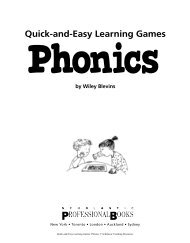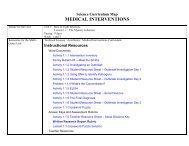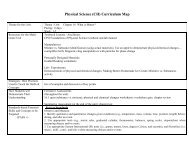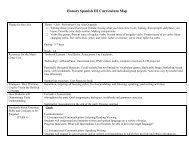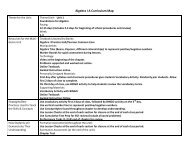Algebra II Curriculum Map - Claremore Public Schools
Algebra II Curriculum Map - Claremore Public Schools
Algebra II Curriculum Map - Claremore Public Schools
Create successful ePaper yourself
Turn your PDF publications into a flip-book with our unique Google optimized e-Paper software.
coordinate axes with labels and scales.A.SSE.1.b: Interpret complicated expressions by viewing one or more of their parts as a single entity. For example,interpret P(1+r)n as the product of P and a factor not depending on P.7-3:F.BF.4.a: Solve an equation of the form f(x) = c for a simple function f that has an inverse and write an expression for theinverse. For example, f(x) =2 x3 for x > 0 or f(x) = (x+1)/(x–1) for x ≠ 1.F.IF.7.e: Graph exponential and logarithmic functions, showing intercepts and end behavior, and trigonometricfunctions, showing period, midline, and amplitude.F.BF.1.b: Combine standard function types using arithmetic operations. For example, build a function that models thetemperature of a cooling body by adding a constant function to a decaying exponential, and relate these functions to themodel.A.CED.2: Create equations in two or more variables to represent relationships between quantities; graph equations oncoordinate axes with labels and scales.A.SSE.1.b: Interpret complicated expressions by viewing one or more of their parts as a single entity. For example,interpret P(1+r)n as the product of P and a factor not depending on P.Concept Byte 7-3:F.IF.4: For a function that models a relationship between two quantities, interpret key features of graphs and tables interms of the quantities, and sketch graphs showing key features given a verbal description of the relationship. Keyfeatures include: intercepts; intervals where the function is increasing, decreasing, positive, or negative; relativemaximums and minimums; symmetries; end behavior; and periodicity.7-4:Prepares for F.LE.4: For exponential models, express as a logarithm the solution to abct = d where a, c, and d arenumbers and the base b is 2, 10, or e; evaluate the logarithm using technology.7-5:F.LE.4: For exponential models, express as a logarithm the solution to abct = d where a, c, and d are numbers and thebase b is 2, 10, or e; evaluate the logarithm using technology.A.REI.11: Explain why the x-coordinates of the points where the graphs of the equations y = f(x) and y = g(x) intersect arethe solutions of the equation f(x) = g(x); find the solutions approximately, e.g., using technology to graph the functions,make tables of values, or find successive approximations. Include cases where f(x) and/or g(x) are linear, polynomial,rational, absolute value, exponential, and logarithmic functions.Concept Byte 7-5:F.IF.8: Write a function defined by an expression in different but equivalent forms to reveal and explain differentproperties of the function.F.IF.7.e: Graph exponential and logarithmic functions, showing intercepts and end behavior, and trigonometricfunctions, showing period, midline, and amplitude.7-6:





